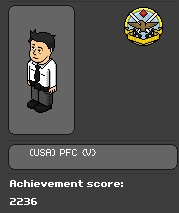Welcome to the virtual Habbo world! Habbo is a virtual hotel where users can create avatars to explore public and private rooms created by the community. Similar to yesterday’s post, my aim is to discover the different ways in which identity is constructed on Habbo through participant observation. I’ll be using the three themes (physical structure, social structure, and interpersonal relationships) as the framework for my analysis.
To begin, I created a Habbo account under the pseudonym MMEDIA3B03. Upon registration, I was prompted to create an avatar in order to enter the virtual world.
The avatar is a part of the physical structure of Habbo. It is used as a representation of one’s self within the virtual community. For some, the avatar is a projection of their own identity, while for others, it is an experiment to form a new identity.
As the new kid on the block, I had to find a way to integrate myself into the community. My avatar only served as a physical identity with no substance. In other words, I felt like a lost avatar within the larger community.
A sense of community is what gives these individual avatars an identity. The social structure of the hotel rooms allow users to create and enter rooms on the basis of their own personal interests. During the observation period, I entered rooms of various categories (e.g., adoption centres, hospitals, army bases, etc.) which served as a social space for the various sub-communities. These sub-communities is what gives individual identities a collective identity within the larger virtual community. Let’s use the army base as an example:
This is a hotel room referred to as the US Army Base. As we can see, all the members of this sub-community are donned in uniforms. If we compare and contrast my avatar on the bench, and the uniformed avatars sitting by the computers, we can easily identify the uniformed avatars with a specific community. My avatar however, is unidentifiable – indicating that the uniform is significant in marking a users identity.
Whereas uniforms are used as a method of identification within the larger Habbo community, ranking is a method of identity construction used by the sub-community to identify each other.
 As we can see, this users biography consists of the title (USA) PFC (V). PFC stands for private first class of the US Army, and the V stands for the training this user has completed. The title in itself demonstrates the language of this collective identity. Only users who identify with this particular sub-community are able to translate and understand the significance of this ranking. The rank structure in itself defines the status and prestige of the individual user within the sub-community in which they belong.
As we can see, this users biography consists of the title (USA) PFC (V). PFC stands for private first class of the US Army, and the V stands for the training this user has completed. The title in itself demonstrates the language of this collective identity. Only users who identify with this particular sub-community are able to translate and understand the significance of this ranking. The rank structure in itself defines the status and prestige of the individual user within the sub-community in which they belong.
This practice is known as role adoption or role playing within the social structure. Role adoption is a significant form of identity construction within the Habbo community. Throughout the duration of my observation, I had come across a variety of role adopted identities including babies, animals, army men, and nurses. The individual hotel rooms are constructed around these role adopted identities. For example, the hospital:
As we can see, these users have adopted the roles of nurses and patients. This scene mimics the real life structures and procedures of a real life hospital (i.e., consulting, health cards, and furniture). Other than creating an identifiable personality within a fairly anonymous environment, role playing is a means for users to create either an aspirational identity, or an identity in which users are unable to demonstrate offline.
The last thing I observed during my observations was interpersonal relationships. I noticed a significant contrast between how interpersonal relationships function on Twitter and Habbo. For one, reciprocity is a social expectation on Habbo. During my two hour observation period, I had been approached countless times, received an infinite amount of friend requests, and engaged in dialogue with numerous users. But what I found to be the most interesting was this users ability to confide in a fellow community member about his offline identity.
In my Twitter observation, I mentioned “Me-Tweets” that were almost always positive in nature. We can see however, that this user doesn’t need to only portray his aspirational best self. He is able to portray a truthful representation of his offline identity. Unlike the distorted interpersonal relationships that form between Twitter users, the interpersonal relationships between Habbo users mirror the relationships formed in real life (i.e., support structure). This is due to three main factors: reciprocity, anonymity and escapism.
The contrast between the construction of identity between these two virtual communities is significant. Whereas, Twitter encourages a one-dimensional representation of identity (the best self), Habbo is a virtual space which encourages a pluralist representation of identity. In other words, you can be who you want to be.
To conclude, these are the following ways in which identity is constructed within the virtual community of Habbo:
- Through the physical structure of the avatar
- Through the social structure of role adoption
- Through the interpersonal relationships afforded by reciprocity, anonymity, and escapism
For my next two posts, I will be moving away from participant observation, and onto my next methodology – interviewing. Through this particular methodology, I will aim to find answers to my second research question:
- How do the citizens of Twitter compare their real-life identity with their virtual identity? What about the citizens of Habbo Hotel?
Until then, enjoy the rest of your weekend!








